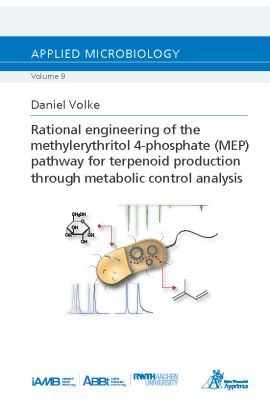Dieses E-Book können Sie hier herunterladen.
Due to an increasing demand for sustainable chemicals, new strategies have to be explored to produce these resources at a low-cost and with low environmental impact. Microbially produced terpenoids are a promising source for a broad spectrum of valuable compounds and industrial precursors. The 2 C methyl D erythritol 4 phosphate (MEP) pathway produces the precursor for terpenoid biosynthesis, but previous metabolic engineering attempts focusing on applying the MEP pathway in the production of terpenoids have met with limited success.
Heterologous expression of an isoprene synthase (ispS) gene in Escherichia coli enabled the strain to produce isoprene. Metabolic characterization revealed the accumulation of isopentenyl pyrophosphate (IPP) in this strain, which led to growth impairment. Through coexpression of the native isopentenyl pyrophosphate isomerase (idi), accumulation of IPP was reduced and normal growth was restored, together with higher isoprene production. To further increase isoprene production, the module expressing ispS and idi was combined with a second module encoding different combinations of native MEP pathway genes, namely dxs, ispD, ispG and ispH. All engineered E. coli strains displayed elevated levels of 2 C methyl D erythritol 2,4-cyclopyrophosphate (MEcPP). Overexpression of IspG, the MEcPP metabolizing enzyme, did not reduce the MEcPP concentration. Additional expression of further MEP pathway genes (dxr, IspE, IspF) did not improve isoprene titers.
Subsequently, metabolic control analysis was applied to investigate the influence of enzyme activity on intermediate concentrations and fluxes in the MEP pathway. For this purpose, libraries of E. coli mutants with altered expression of the MEP pathway genes were generated and quantified. After transformation of the library with the isoprene production module, the intermediate concentrations and fluxes in the MEP pathway revealed a strong flux control coefficient of Dxs towards isoprene (0.41) at wild type expression level, while Dxs showed less control at higher expression levels. The MEcPP concentration caused a massive increase in the levels of MEcPP, while the levels of IPP/DMAPP reached saturation. The high concentration caused increased efflux of MEcPP. It is concluded that IspG is operating close to its maximum reaction rate at higher dxs expression levels and therefore is limiting the flux through the MEP pathway.
| Autor | Volke, Daniel |
|---|---|
| Lieferzeit | 3-4 Tage |
| Gewicht | 0.278 kg |
| Erscheinungsdatum | 25.07.2018 |
Applied Microbiology
Rational engineering of the methylerythritol 4-phosphate (MEP) pathway for terpenoid production through metabolic control analysis (E-Book)
Kurzbeschreibung
Dieses E-Book können Sie hier herunterladen.
Terpenoids include high value chemicals such as pharmaceuticals, chemical precursors and fine chemicals. Fruthermore, terpenoids are of interest as environmental-friendly replacement of fossil derivate chemicals. Here, the 2 C methyl D erythritol 4 phosphate (MEP) pathway was analyzed in Escherichia coli through metabolic control analysis for production of the model terpenoid isoprene. Several limiting steps were identified and their implication for an efficient pathway design is discussed.

